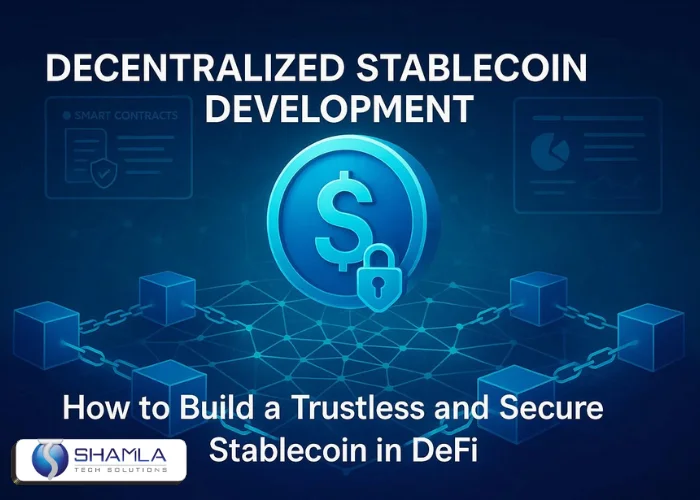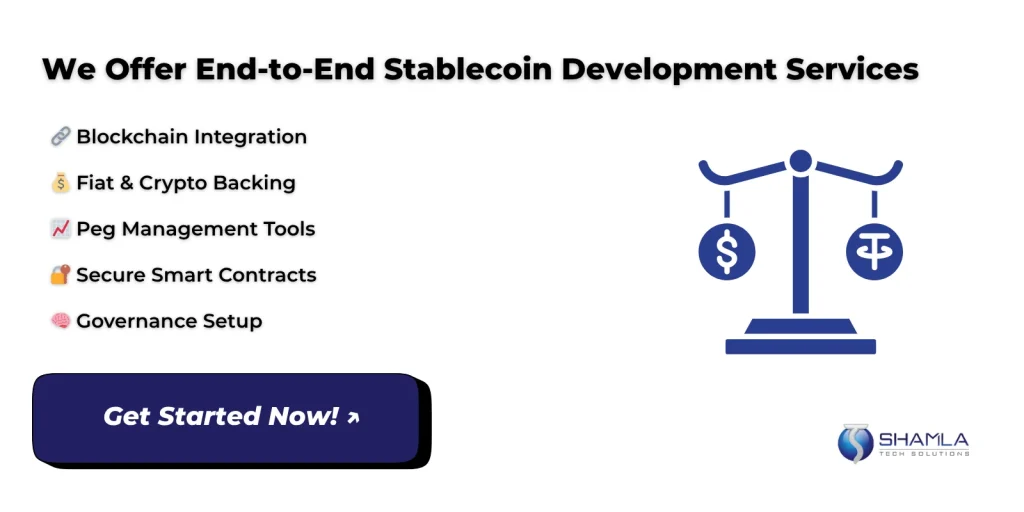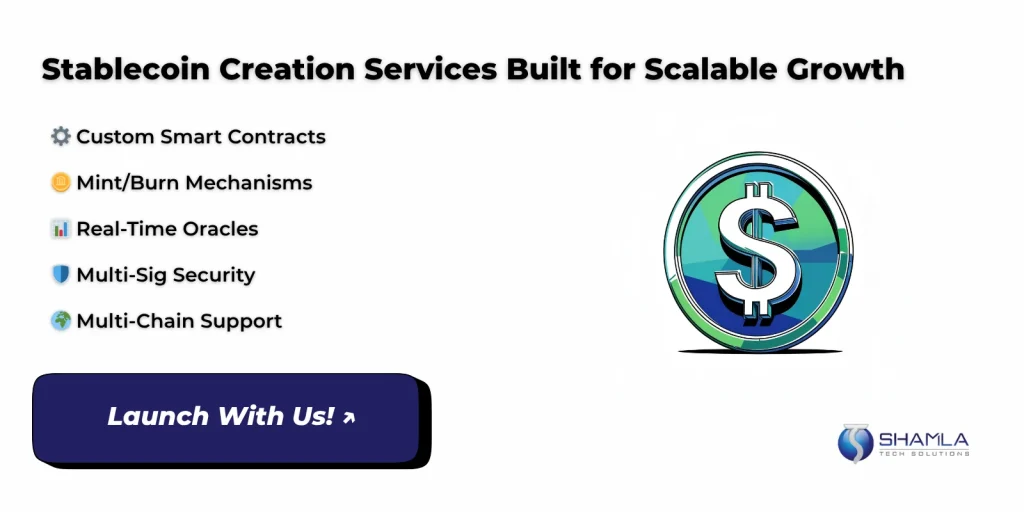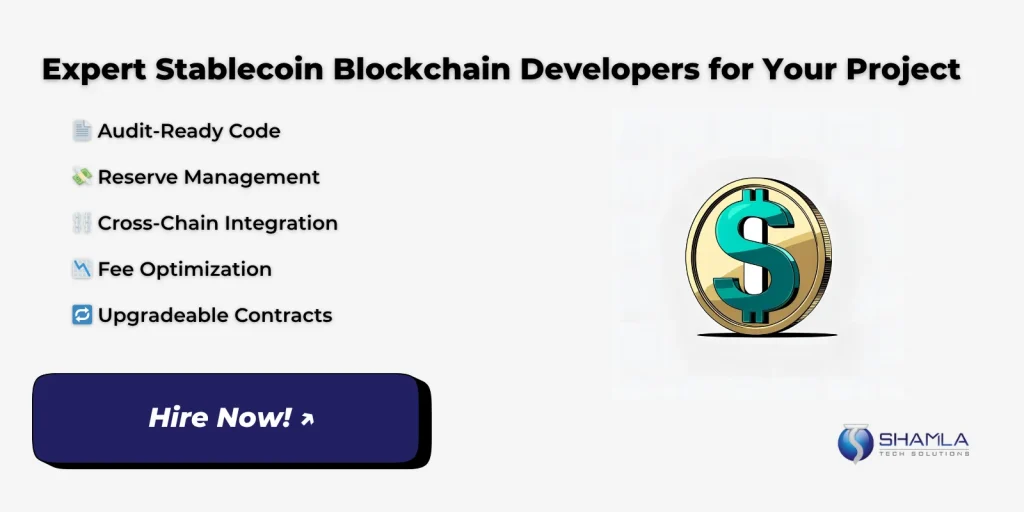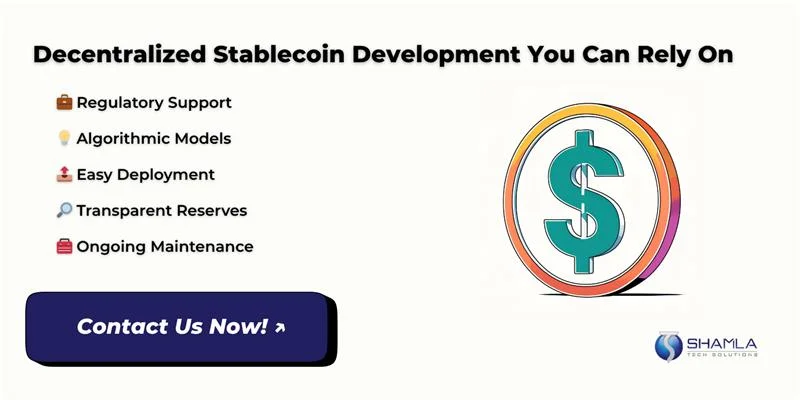Decentralized stablecoin development creates digital tokens that keep their value steady without a central bank. It uses blockchain networks and smart contracts to control supply and track assets. Developers design tools like extra collateral or automatic adjustments to keep price stable against a reference asset.
This approach boosts financial access, cuts cross-border fees, and supports fast trading in DeFi markets. Clear code, reliable oracles, and strict audits ensure openness and prevent hacks. As on-chain lending, trading, and payments grow, secure token design drives stablecoin adoption and builds trust in open finance systems. Developers must balance risk and efficiency throughout robustly.
The Fundamentals of Decentralized Stablecoin Development
1. Decentralization and Security Foundations
2. Algorithmic vs Asset-Backed Models Overview
3. Algorithmic Stablecoin Mechanics
Algorithmic stablecoin development focuses on supply rules and feedback loops. Contracts monitor price feeds and adjust token supply automatically. Two main patterns:
- Expansion: System mints tokens when price > peg and distributes to reserve funds.
- Contraction: System burns tokens or sells collateral when price < peg to restore value.
Developers tune parameters like adjustment speed, oracle delay and reserve limits. Algorithmic stablecoin development demands careful modeling to prevent instability and bank run scenarios. Simulations test failure modes under extreme price swings. Peer reviews verify formula logic. This model avoids reserve costs but trades off capital backing for dynamic supply control.
4. Asset-Backed Stablecoin Design
5. Key DeFi Ecosystem Use Cases
Stablecoins enable borrowing, trading, and earning yield in DeFi. Key use cases include:
- Lending protocols: Users borrow or lend assets using stablecoins as collateral
- Automated market makers: Pools pair stablecoins with other tokens to enable swaps
- Yield farming: Strategies lock stablecoins in vaults for interest
- Cross-chain bridges: Stablecoins transfer value between networks
Stablecoin blockchain developers integrate these coins into smart vaults, routers and composite products. High liquidity and price stability lower risk for users. Transparent on-chain tracking records all flows. This constant utility drives broad adoption and underpins decentralized finance services globally in an open permissionless and secure environment.
6. Step-by-Step Creation Guide
Building Your Own Decentralized Stablecoin: Process, Technology, and Tools
1. Concept and Planning
2. Smart Contract Design
Leverage stablecoin smart contract development services or stablecoin development services to code key modules:
- Collateral Manager: Locks and releases backing assets
- Mint/Burn Engine: Issues and destroys tokens per rules
- Oracle Interface: Reads external price feeds
- Circuit Breaker: Halts operations on severe faults
Embed checks for input ranges, gas limits and reentrancy. Include event logs for each state change. Rigorous unit tests simulate edge cases. This detailed contract build drives safe decentralized stablecoin development.
3. Oracle Integration and Data Feeds
Set up accurate pricing for your stablecoin by connecting trusted oracle services.
Choose between:
- Decentralized Aggregators: Combine multiple sources for fault tolerance
- Single-Source Oracles: Low-latency updates from a trusted provider
- Hybrid Models: On-chain feeds with off-chain verification
Configure update intervals, deviation thresholds and fallback modes. Implement on-chain checks that reject stale or outlier data. Connect to a stablecoin launch platform that supports your chosen chains and gas structures. Thorough oracle testing under simulated network stress cements decentralized stablecoin development, preventing price drifts and manipulations before public launch.
4. Governance and Audit
5. Platform Selection and Deployment
Choose a stablecoin launch platform that matches your network needs and budget. Evaluate:
- Supported Chains: Ethereum, BNB Smart Chain, or Layer-2s
- Gas Models: Fixed vs. dynamic fees
- Deployment Tools: CLI scripts, IDE plugins or web dashboards
- Post-Launch Support: Migration guides, hotfix channels
Use platform SDKs to automate contract deployment, verify on explorers and register token metadata. Coordinate with bridge teams if multi-chain support is needed. A robust launch platform simplifies live rollout and initial liquidity seeding, ensuring smooth market entry.
6. Post-Deployment Management
Choosing the Right Stablecoin Development Partner or Platform
1. Proven Expertise and Robust Security
2. Track Record of Delivery and Support
3. Rigorous Audits and Regulatory Readiness
4. Flexible Tech Stack and Custom Solutions
5. End-to-End Deployment and Ongoing Management
6. Value-Driven Pricing and Long-Term Collaboration
Regulation, Adoption & Revenue: Real-World Stablecoin Insights
1. Global Rules and Compliance
2. Drivers of Market Usage
3. Issuer Revenue Mechanics
- Seigniorage Fees: Small charge on minting and burning operations
- Reserve Yields: Interest earned on collateral assets in safe pools
- Transaction Fees: Micro-fees on transfers or protocol interactions
- Governance Tokens: Sale of native tokens that share protocol profits
Lessons from Top Stablecoins and Cost Factors
Studying the top 10 stablecoins reveals key design patterns and risks. Backed tokens benefit from clear audits and deep liquidity; algorithmic stablecoin development models need robust feedback loops to avoid bank-run spirals. Multi-signature custody and staggered reserve locations limit single-point failures.
Decentralized governance with on-chain voting speeds protocol fixes. Meanwhile, the cost of stablecoin development hinges on audit packages, oracle integrations, insurance and legal work. Teams must budget for smart contract reviews, infrastructure nodes and compliance tooling. Careful planning aligns expenses with launch scope and long-term protocol health.
Conclusion
Decentralized stablecoin development removes single points of failure by using open code and shared networks. Smart contracts automate minting, burning and collateral checks. Real-time oracles anchor value without intermediaries. Distributed consensus secures transactions and prevents censorship. Transparent reserves and automated governance build trust and resist manipulation. Lower costs, faster settlement.
Shamla Tech is a top stablecoin development company offering custom stablecoin creation services with end-to-end support. Our team builds secure contracts, integrates reliable oracles and sets up governance modules. We deploy contracts on multiple networks, automate audits and ensure compliance. Partner with us to launch robust, flexible stable tokens that scale seamlessly and gain market trust.
Want to launch your own stablecoin? Let Shamla Tech build it for you!
Secure, scalable, and compliant – Contact us today to get started!

